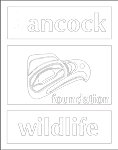OUR HISTORY
David Hancock initiated a study of bald eagles in the middle 1950’s on southern Vancouver Island, expanded this in the 1960’s to an extensive review of the eagle population productivity in sections of the Gulf Islands, Barkley Sound and parts of the Great Bear Rain Forest of central BC. In more recent years he has repeated some of the Gulf Island surveys but primarily concentrated on the nesting and wintering populations of eagles in the Greater Vancouver / Lower Fraser Valley area.
The nesting populations in the Lower Fraser Valley have gone from 3 pairs found during the early 1960’s immediately following the period when a $2.00 per pair of eagle legs bounty was paid to fisherman and game wardens by the State of Alaska for killing eagles to today when it is estimated that over 500 nesting pairs are now breeding in the valley. By 2018 David has recorded over 400 of these active nests in the lower valley. This region covers from the north Shore from West Vancouver southward across the mouth of the Fraser River to to Point Roberts Washington then eastward to Hope forming a triangular wedge of about ??? square miles ( ??square km)l
The wintering studies primarily focused on two study areas. The first was the Harrison-Chehalis River complex from the Fraser River upstream to include the Chehalis Flats — the home of the Fraser Valley Bald Eagle Festival and the site of the Chehalis Flats Bald Eagle & Salmon Reserve initiated by the HWF . This region, while it supports nearly a dozen nesting pairs of eagles, is the primarily feeding and loafing area for eagles on the entire west central North American coast. One count on December 18, 2010 yielded 7362 eagles in a 3 km section of the Chehalis Flats. We are working at correlating the number of eagles with ecological variables, particularly numbers of salmon on the northern Alaska and BC rivers but also with variations in the onset of winter freezing.
The wintering study area has been expanded to cover all the lower Fraser Valley including the region surrounding Boundary Bay from the water’s edge inland to include the Vancouver Landfill enclosure north of Highway 99 and bounded to the east including Surrey and to the west by the land bordering the Salish Sea. This area is proving to be not just a prime breeding habitat with 78 active pairs nesting in the City of Delta, 39 active breeding territories in Surrey and another 11 active territories in Point Roberts Washington State, all areas surrounding Boundary Bay and adjacent diked farmlands and the Vancouver Landfill. It is now apparent that this area from Hope to the Salish Sea undoubtedly representative the world’s best year round eagle habitat – an incredibly human-enriched environment for the greatest sea eagle gatherings in the world.
The Hancock Wildlife Foundation, with the support of many other local conservation organizations and in cooperation with Simon Fraser University is now taking on the responsibility of understanding where these estimated 35,000 wintering eagles come from and where our 1000 nesting birds go to after breeding. The recently launched 10 year BETA Project (The Bald Eagle Tracking Alliance) hopes to bring an understanding of these eagle movements, where and what pollutants they are picking up by analyzing the isotopes in the feathers and how they are adapting to our changing ecological times. Please watch and follow the daily movements of these gps tracked eagles as they cover their incredible world. I write this note March 13 as we are tracking our first 5 eagles carrying the gps markers — and already the most unexpected movement are beginning to be revealed. I find this a most incredible opportunity to finally learn the goings and comings of the world’s largest gatherings of a large eagle. Please follow an eagle!
In summary the Hancock Wildlife Foundation is involved in a whole series of educational outreach projects from introducing live streaming eagles CAMs to the world, to undertaking school projects about understanding ecological sustainability to now allowing individuals and schools to follow these wondrous creatures as we finally find where our eagles come from and go to. These outreach projects are of course based on a number of scientific studies from censusing wintering eagles, recording breeding distribution and success and now tracking the eagle’s annual movements.
The Not-for-Profit Foundation depends upon our volunteers helping with the projects, with assisting managing the WEB site, helping get data onto the site and also getting out to help in attending local events to display our eagle conservation stories – and to support our funding-raising events to support the CAMs and the scientific projects. The HWF has no employees, only volunteers, though we have to pay for the CAMs and their technical support. David Hancock and the team have also acted in giving ‘mitigation advice’ when nesting eagle habitat is threatened and often this advice generates a fee or donation that goes to covering our field efforts and developing bald eagle habitat (see Bald Eagle Preserve). Also the team undertakes many annual events to give illustrated talks on bald eagles, habitat management and even on how to build eagle nests in your area. The balance of the Foundation’s funding is from our supporters making donations — for which we thank you immensely. Please think and support an ecologically sustaInable world: “support a nest” , “follow an eagle” , “support an educational project” or contribute to “habitat preservation”.
David Hancock
